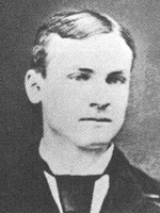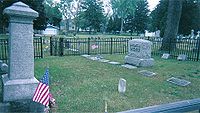
Henry Armstrong Reed
Encyclopedia
Henry Armstrong Reed was the nephew of George Armstrong Custer
, Thomas Custer
, and Boston Custer
. Although not an official soldier, he was killed along with them at the Battle of the Little Bighorn
at the age of 18.
, Michigan
. While he had several sisters, he was the only son of David and Lydia Reed. At a young age, he was given the nickname “Autie” by his mother— a nickname of his middle name Armstrong, which was also shared by his uncle George Armstrong Custer.
in the Dakota Territory
.
There, he was hired on May 10 to serve as a beef herder
for the 7th Cavalry Regiment, which was under the command of George Armstrong Custer.
 Reed joined the 7th Cavalry Regiment shortly after the start of the Great Sioux War of 1876–77
Reed joined the 7th Cavalry Regiment shortly after the start of the Great Sioux War of 1876–77
in the Montana Territory
, part of the larger American Indian Wars. While Reed was never officially enlisted as a soldier, he volunteered his services as such for the Battle of the Little Bighorn
on June 25, 1876. Under normal circumstances, this would be prohibited, but since he was part of the “Custer Clan” with his three uncles, he was granted permission by them to partake in the battle. The regiment’s orderly, John Burkman, argued for Reed to stay back with the herding train where he belonged. Burkman himself was ordered to stay behind, and Reed taunted him by saying, “You’re mad because you can’t go along” before riding off on his horse for combat.
, Boston
, and Thomas
— and Reed’s uncle-in-law James Calhoun
. Reed was killed atop Last Stand Hill, and his head was scalped
and body mutilated by the victorious Indian forces, as were the majority of those killed in the battle. A marble marker was erected at the exact site where his body was recovered several days later.
He was originally buried on the battlefield, but a year later, his body was exhumed and interred at the Woodland Cemetery
in his hometown of Monroe, Michigan
, while the marble marker remains in its location in the present-day Little Bighorn Battlefield National Monument
. Interestingly, his removed scalped is on display at the Museum of World Treasures
in Wichita, Kansas
.
George Armstrong Custer
George Armstrong Custer was a United States Army officer and cavalry commander in the American Civil War and the Indian Wars. Raised in Michigan and Ohio, Custer was admitted to West Point in 1858, where he graduated last in his class...
, Thomas Custer
Thomas Custer
Thomas Ward Custer was a United States Army officer and two-time recipient of the Medal of Honor for bravery during the American Civil War...
, and Boston Custer
Boston Custer
Boston Custer was the youngest brother of U.S. Army General George Armstrong Custer and two-time Medal of Honor recipient Captain Thomas Custer...
. Although not an official soldier, he was killed along with them at the Battle of the Little Bighorn
Battle of the Little Bighorn
The Battle of the Little Bighorn, also known as Custer's Last Stand and, by the Indians involved, as the Battle of the Greasy Grass, was an armed engagement between combined forces of Lakota, Northern Cheyenne and Arapaho people against the 7th Cavalry Regiment of the United States Army...
at the age of 18.
Early life
Henry Reed was born on April 27, 1858 in MonroeMonroe, Michigan
Monroe is a city in the U.S. state of Michigan. The population was 20,733 at the 2010 census. It is the largest city and county seat of Monroe County. The city is bordered on the south by Monroe Charter Township, but both are politically independent. The city is located approximately 14 miles ...
, Michigan
Michigan
Michigan is a U.S. state located in the Great Lakes Region of the United States of America. The name Michigan is the French form of the Ojibwa word mishigamaa, meaning "large water" or "large lake"....
. While he had several sisters, he was the only son of David and Lydia Reed. At a young age, he was given the nickname “Autie” by his mother— a nickname of his middle name Armstrong, which was also shared by his uncle George Armstrong Custer.
Indian wars
Heavily influenced by his military uncles, he followed in their footsteps and left Monroe in May 1876 with his sister Emma for Fort Abraham LincolnFort Abraham Lincoln
Fort Abraham Lincoln State Park is located seven miles south of Mandan, North Dakota. The park is home to On-A-Slant Indian Village, the blockhouses and the Custer house...
in the Dakota Territory
Dakota Territory
The Territory of Dakota was an organized incorporated territory of the United States that existed from March 2, 1861, until November 2, 1889, when the final extent of the reduced territory was split and admitted to the Union as the states of North and South Dakota.The Dakota Territory consisted of...
.
There, he was hired on May 10 to serve as a beef herder
Herder
A herder is a worker who lives a possibly semi-nomadic life, caring for various domestic animals, in places where these animals wander pasture lands....
for the 7th Cavalry Regiment, which was under the command of George Armstrong Custer.

Great Sioux War of 1876–77
The Great Sioux War of 1876, also known as the Black Hills War, was a series of battles and negotiations which occurred between 1876 and 1877 involving the Lakota and Northern Cheyenne, against the United States...
in the Montana Territory
Montana Territory
The Territory of Montana was an organized incorporated territory of the United States that existed from May 28, 1864, until November 8, 1889, when it was admitted to the Union as the State of Montana.-History:...
, part of the larger American Indian Wars. While Reed was never officially enlisted as a soldier, he volunteered his services as such for the Battle of the Little Bighorn
Battle of the Little Bighorn
The Battle of the Little Bighorn, also known as Custer's Last Stand and, by the Indians involved, as the Battle of the Greasy Grass, was an armed engagement between combined forces of Lakota, Northern Cheyenne and Arapaho people against the 7th Cavalry Regiment of the United States Army...
on June 25, 1876. Under normal circumstances, this would be prohibited, but since he was part of the “Custer Clan” with his three uncles, he was granted permission by them to partake in the battle. The regiment’s orderly, John Burkman, argued for Reed to stay back with the herding train where he belonged. Burkman himself was ordered to stay behind, and Reed taunted him by saying, “You’re mad because you can’t go along” before riding off on his horse for combat.
Death
The Battle of the Little Bighorn proved a disastrous defeat for the 7th Cavalry Regiment. Reed was killed, as were all three of his uncles— GeorgeGeorge Armstrong Custer
George Armstrong Custer was a United States Army officer and cavalry commander in the American Civil War and the Indian Wars. Raised in Michigan and Ohio, Custer was admitted to West Point in 1858, where he graduated last in his class...
, Boston
Boston Custer
Boston Custer was the youngest brother of U.S. Army General George Armstrong Custer and two-time Medal of Honor recipient Captain Thomas Custer...
, and Thomas
Thomas Custer
Thomas Ward Custer was a United States Army officer and two-time recipient of the Medal of Honor for bravery during the American Civil War...
— and Reed’s uncle-in-law James Calhoun
James Calhoun (soldier)
James Calhoun was a soldier in the United States Army during the American Civil War and the Black Hills War...
. Reed was killed atop Last Stand Hill, and his head was scalped
Scalping
Scalping is the act of removing another person's scalp or a portion of their scalp, either from a dead body or from a living person. The initial purpose of scalping was to provide a trophy of battle or portable proof of a combatant's prowess in war...
and body mutilated by the victorious Indian forces, as were the majority of those killed in the battle. A marble marker was erected at the exact site where his body was recovered several days later.
He was originally buried on the battlefield, but a year later, his body was exhumed and interred at the Woodland Cemetery
Woodland Cemetery (Monroe, Michigan)
Woodland Cemetery, formerly known as Grove Cemetery and Woodlawn Cemetery, is a public, city-owned cemetery located at 428 Jerome Street in southeast Monroe, Michigan. It occupies 10 acres and contains over 6,500 graves. Founded in 1810, it is one of Michigan’s oldest public cemeteries...
in his hometown of Monroe, Michigan
Monroe, Michigan
Monroe is a city in the U.S. state of Michigan. The population was 20,733 at the 2010 census. It is the largest city and county seat of Monroe County. The city is bordered on the south by Monroe Charter Township, but both are politically independent. The city is located approximately 14 miles ...
, while the marble marker remains in its location in the present-day Little Bighorn Battlefield National Monument
Little Bighorn Battlefield National Monument
Little Bighorn Battlefield National Monument preserves the site of the June 25, 1876, Battle of the Little Bighorn, near Crow Agency, Montana, in the United States. It also serves as a memorial to those who fought in the battle: George Armstrong Custer's 7th Cavalry and a combined Lakota-Northern...
. Interestingly, his removed scalped is on display at the Museum of World Treasures
Museum of World Treasures
The Museum of World Treasures is a world history museum in Wichita, Kansas, United States. Among the many items on display are Tyrannosaurus, Daspletosaurus, and Tylosaurus specimens , Egyptian mummies, signatures of all the American presidents, a section of the Berlin Wall, and the Scarecrow's...
in Wichita, Kansas
Wichita, Kansas
Wichita is the largest city in the U.S. state of Kansas.As of the 2010 census, the city population was 382,368. Located in south-central Kansas on the Arkansas River, Wichita is the county seat of Sedgwick County and the principal city of the Wichita metropolitan area...
.
Further reading
- Connell, Evan S., Son of the Morning StarSon of the Morning StarSon of the Morning Star is a 1984 non-fiction book on the subject of George Armstrong Custer, with the subtitle 'Custer and the Little Bighorn'. A 1991 television film was based on the book. Both the book and the film chronicle the Battle of the Little Bighorn, the personalities involved, and the...
, 1984, ISBN 0-06-097161-4 - Frost, Lawrence A., The Custer Album, 1984, ISBN 0-517-42714-1
- Monaghan, Jay, Custer: The Life of General George Armstrong Custer, 1971, ISBN 0-803-25732-5

